
Contents


Free From Human Intrusion


Dreaming of Delightful Zone

Take You to the DMZ

Seeing With the Mind, Talking Through the Lens

the Design of Handheld Fans


Shared Together for Double the Happiness


Founded in the Spirit of Candlelight

Japchae, Shared Together
for Double the Happiness
A Feast of Mixed Vegetables
People prepare japchae stir-fried glass noodles with vegetables to welcome important guests. The dish, made from a variety of ingredients, is truly a gift from the heart. The glass noodles are first soaked in water, and the vegetables are washed and sliced. According to the recipe in “Eumsik Dimibang,” a book published in 1670, japchae at that time did not actually contain glass noodles, but featured more than 20 vegetables, such as cucumbers, radishes, several varieties of mushroom, and bellflower roots. Those who eat japchae stir-fried glass noodles with vegetables today cannot help but praise the dish, and this brings love and laughter to the dining table. Japchae may be a source of joy or merely a part of an already wholesome meal. Regardless, there is no denying that it has become deeply rooted in our lives.
Written by Lee Ju-eun Photographed by Studio Kenn

Everybody Loves Japchae
Japchae stir-fried glass noodles with vegetables (잡채) is a dish of stir-fried glass noodles made from sweet potato or potato starch, with meat and vegetables added to the mix. The character jap (잡) means “to mix,” while chae (채) means “vegetables.” It’s literally a mix of various vegetables. Thanks to its mild flavors, it is a favorite of young and old alike. It has also gained popularity among non-Koreans after it was added to the menu in the hit reality cooking TV show “Youn’s Kitchen.” The soft texture of the glass noodles, the soy sauce marinade, and the rich scent of sesame oil come together to create a perfect dish for festive occasions. The same dish makes a highly nutritious and healthy meal for non-Koreans. Vegetarians can also enjoy the non-beef version of japchae.
While the most common type of japchae stir-fried glass noodles with vegetables features glass noodles as the main ingredient, many different varieties are born depending on the choice of ingredients. They include gochu-japchae made with shredded peppers, buchu-japchae made with chives, ueong-japchae made with burdock roots, and juksun-japchae made with bamboo shoots.
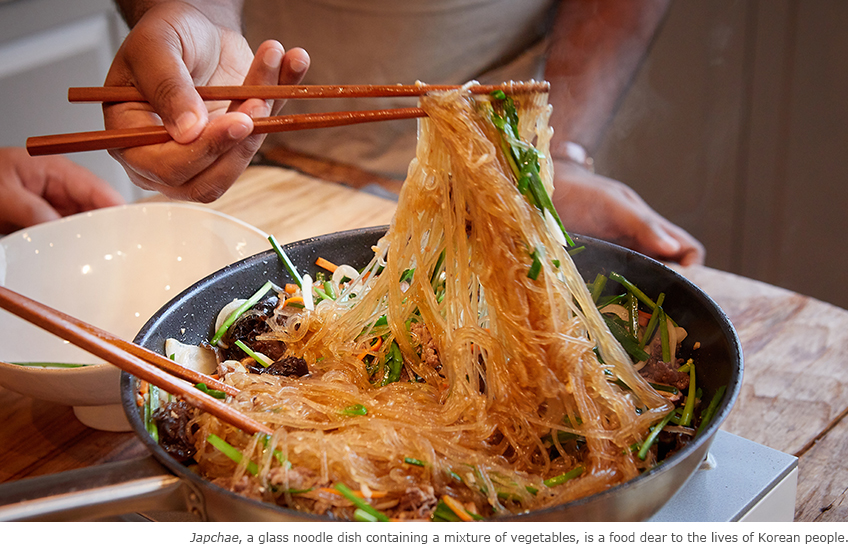
Food with Friends
In the June issue of KOREA monthly, we will learn to cook japchae stir-fried glass noodles with vegetables with Das from India and with Paul from the U.S.
Das and Paul met three years ago at graduate school in Korea, and soon became best friends while sharing their experiences learning Korean language, traditions and cuisine. They cooked curry together when Das had a craving for some Indian food. Paul, a Korean-American who moved to the U.S. at the age of four, is more familiar with U.S. cuisine than Korean cuisine, but he speaks fluent Korean because his father encouraged him to speak Korean at home. Many people who hear Paul speak Korean think he’s a real Korean, and not just Korean-American.
The two friends are fans of Korean cuisine, and describe japchae stir-fried glass noodles with vegetables as “soft and delicious.” When asked if they have ever tried the dish, Das replied, “Of course! Doesn’t it have seaweed?” Paul said, “I haven’t seen japchae with seaweed. Do you mean mushrooms?” The “seaweed” that Das is referring to is, in fact, wood ear mushrooms. The opportunity to cook some Korean food is another way to learn about East Asian ingredients. The two young men with aprons on look as excited as a couple going on a first date.
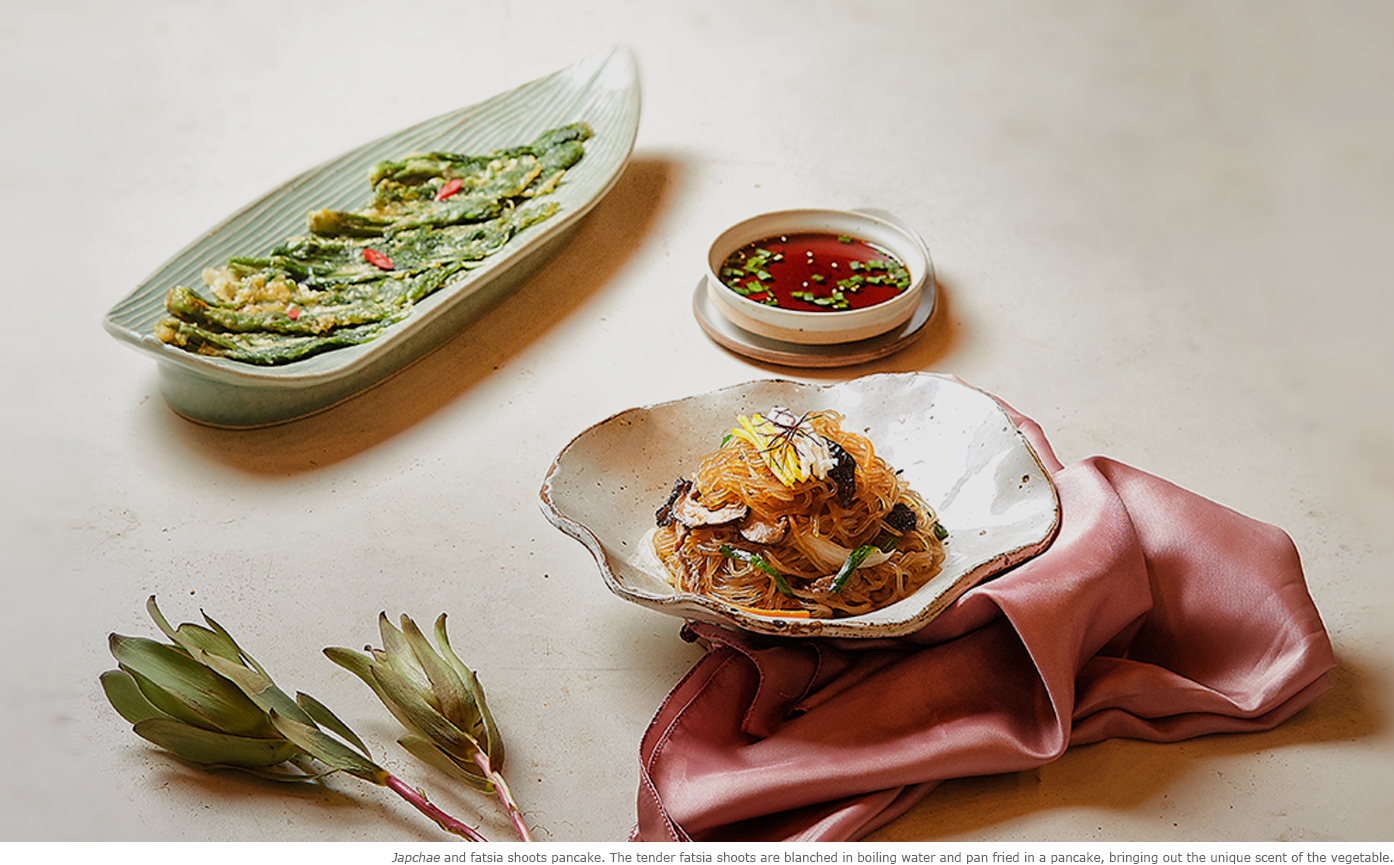
A Dish from the Heart
“First, stir-fry the onions!” At this, Das and Paul seem flustered and confused. They confess, “We know how to eat, but it’s our first time cooking.” They are grateful for this rare chance to learn from a real Korean chef. Das says, “The marinade is made with more ingredients than I’d expected. That’s more than Indian curry!” In slightly broken Korean, he asks the chef, “I get why you need soy sauce, but what about ginger powder? What’s the role of the plum syrup?” As the dish becomes almost complete, the friends look at each other in amazement. Paul, who lives with his grandmother in Korea, says, “Do you think I can do this on my own at home? I’d love to cook this for my grandmother.” He goes on, “She’s lost some of her hearing, so it isn’t easy to have a conversation with her. I hope to make her happy by cooking.”
japchae Create Unforgettable
Memories
The dish is made by stir-frying glass noodles that have been soaked in water and vegetables in a pre-heated pan. It’s ready to serve when topped with an egg garnish and chili shreds. The chef instructs the two friends to place five to six chili shreds on top, and they start to count them one by one. Their plates of japchae stir-fried glass noodles with vegetables look exactly like those in cooking magazines. So begins their love for japchae. Das exclaimed that, “I can’t believe how soft and chewy the noodles are!” Paul said, “I always thought noodles were made with rice. I’m surprised they’re actually made with sweet potato starch. This dish would definitely impress my parents.” The friends take some time to taste their own masterpieces. Das, who is about to return to India, says that the cooking session will be part of his cherished memories. He hopes to make japchae stir-fried glass noodles with vegetables for his friends in India. Japchae, born from the harmony of various ingredients, is the perfect dish to be shared with people from all around the world.
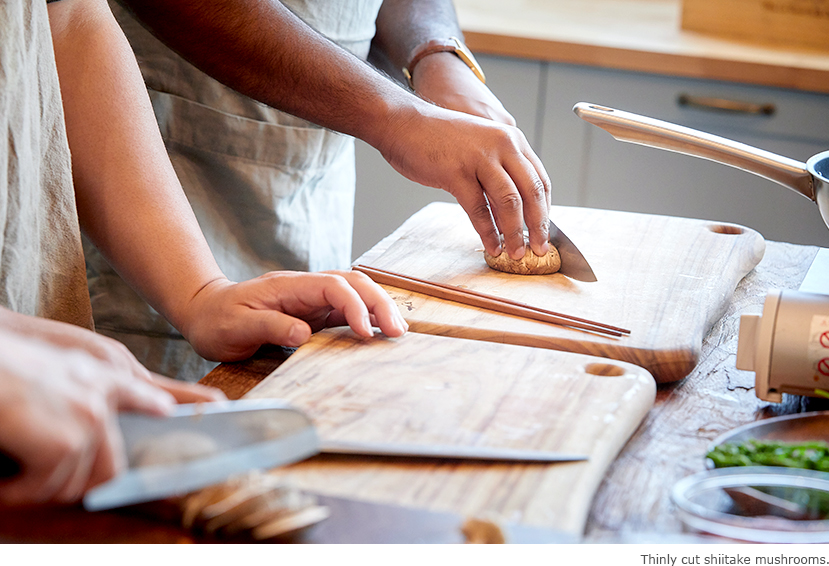
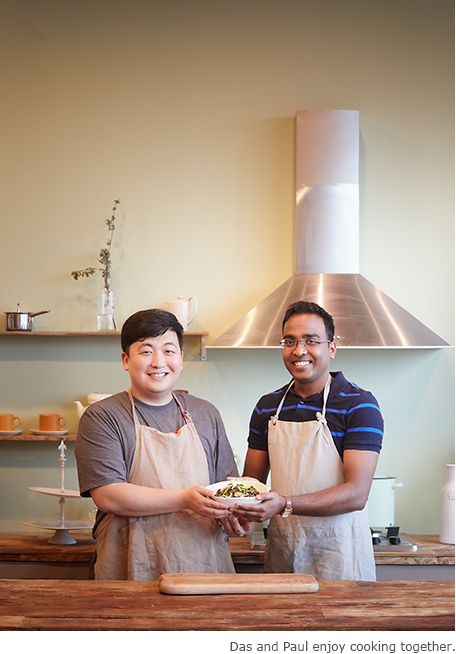
Cooking Tips
Ingredients
250 g glass noodles soaked in water for 10 minutes, 50 g onions, 50 g carrots, 10 g chives, 3 shiitake mushrooms, 3 wood ear mushrooms, 130 g beef, 5 tablespoons soy sauce, ground black pepper, 1 tablespoon minced green onion, 1 tablespoon minced garlic, 1 teaspoon plum syrup, 1 teaspoon ginger powder, 1 teaspoon sugar, cooking oil, egg garnish, chili threads
Instructions
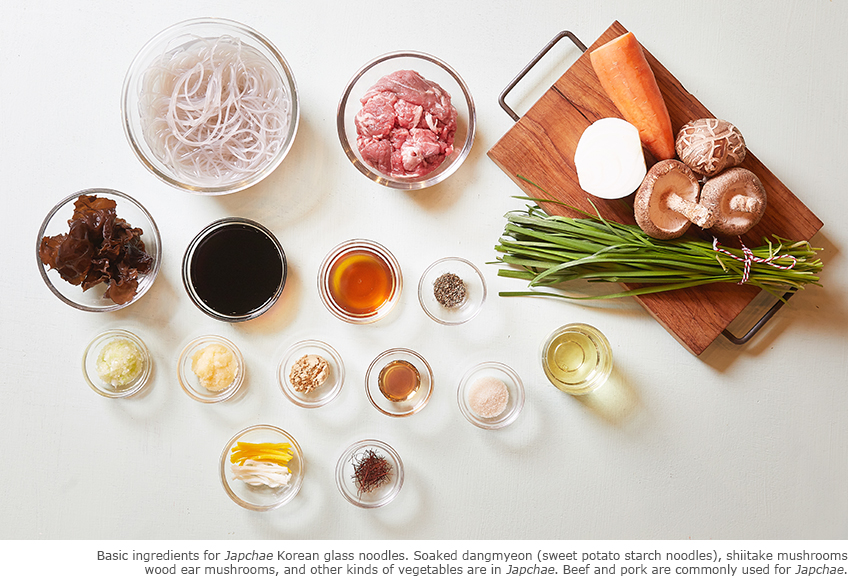
Other Articles



Dreaming of Delightful Zone


Take You to the DMZ

Seeing With the Mind, Talking Through the Lens




Application of subscription
Sign upReaders’ Comments
GoThe event winners
Go


 June 2018
June 2018


